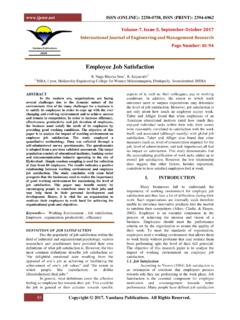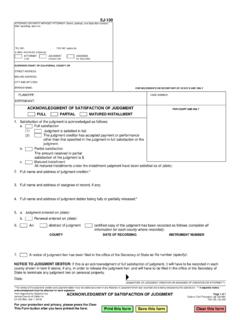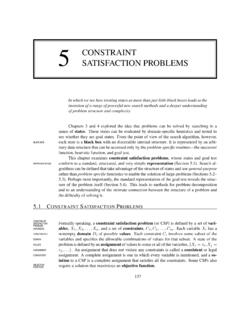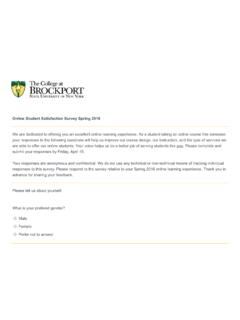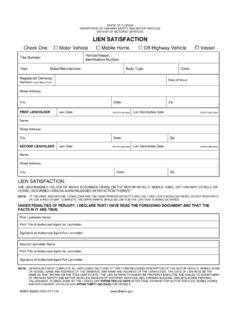Transcription of Online Instruction, E-Learning, and Student Satisfaction ...
1 Online Instruction, E-Learning, and Student Satisfaction : A Three Year Study (SNnOnlineCourses Michele T. Cole, Daniel J. Shelley, and Louis B. Swartz Robert Morris University, United States Abstract This article presents the results of a three-year study of graduate and undergraduate students level of Satisfaction with Online instruction at one university. The study expands on earlier research into Student Satisfaction with e-learning. Researchers conducted a series of surveys over eight academic terms. Five hundred and fifty-three students participated in the study.)
2 Responses were consistent throughout, although there were some differences noted in the level of Student Satisfaction with their experience. There were no statistically significant differences in the level of Satisfaction based on gender, age, or level of study. Overall, students rated their Online instruction as moderately satisfactory, with hybrid or partially Online courses rated as somewhat more satisfactory than fully Online courses. Convenience was the most cited reason for Satisfaction . Lack of interaction was the most cited reason for dissatisfaction.
3 Preferences for hybrid courses surfaced in the responses to an open-ended question asking what made the experience with Online or partially Online courses satisfactory or unsatisfactory. This study s findings support the literature to date and reinforce the significance of Student Satisfaction to Student retention. Keywords: E-learning; instructional design; Online education; Student retention; Student Satisfaction Online Instruction, E-Learning, and Student Satisfaction : A Three Year Study Cole, Shelley, and Swartz Vol 15 | No 6 Creative Commons Attribution International License Dec/14 112 Introduction In their ten-year study of the nature and extent of Online education in the United States, Allen and Seaman (2013) found that interest on the part of universities and colleges in Online education shows no sign of abating.
4 Online education continues to expand at a rate faster than traditional campus-based programs. The authors reported the number of students enrolled in at least one Online course to be at an all-time high of 32% of all enrollments in participating institutions, representing an increase of 570,000 students from the previous year. Allen and Seaman also found that 77% of university leaders responding to the survey rated learning outcomes to be the same, if not better, with Online education when compared with face-to-face learning. Their results support the no significant difference phenomenon that Russell (1999) found in his comparative study of Student learning in the Online and traditional classroom environments.
5 Acknowledging that learning outcomes are equivalent, the question of how satisfied students are with their experiences with e-learning persists. This is important from the stand point of Student retention which is, of course, relevant to enrollment and maintaining institutional revenue streams. Also, analysis of Student Satisfaction may point to improvements in e-learning practices which in turn could improve outcomes. Literature Review The Allen and Seaman (2013) report looked at Online education, including the growing presence of massive open Online courses (MOOCs), from the institutional perspective, not from the Student s.
6 In their report, the authors noted that the remaining barriers to widespread acceptance of Online education were lack of faculty and employer acceptance, lack of Student discipline and low retention rates. Of these, Student retention in Online programs is particularly relevant to the discussion of Student Satisfaction with their Online experience. Reinforcing the instructor s role in designing satisfying Online curricula, Kransow (2013) posited that if students were satisfied with their Online experiences, they would be more likely to remain in the program.
7 Kransow (2013) poses a critical question for instructors working in the Online environment. How can Online courses be designed to maximize Student Satisfaction as well as Student motivation, performance and persistence? Drawing on the literature, Kransow emphasizes the importance of building a sense of community in the Online environment. Yet, building an Online community that fosters Student Satisfaction involves strategies that go beyond facilitating interaction with course components. Building community also requires, among other elements, interaction with each other, that is, between Student and instructor and among students in the course.
8 Sher (2009), in his study of the role such interactions play in Student learning in a Web-based environment, found interaction between Student and instructor and among students to be significant factors in Student Satisfaction and learning. Interaction between the Student and the instructor, among students, and with course content and technology was the focus of Strachota s (2003) study of Student Online Instruction, E-Learning, and Student Satisfaction : A Three Year Study Cole, Shelley, and Swartz Vol 15 | No 6 Creative Commons Attribution International License Dec/14 113 Satisfaction with distance education.
9 In her study, learner-content interaction ranked first as a determinant of Student Satisfaction , followed by learner-instructor and learner-technology interaction. Interaction between and among students was not found to be significantly correlated with Satisfaction . Bollinger (2004) found three constructs to be important in measuring Student Satisfaction with Online courses: interactivity, instructor variables and issues with technology. Palmer and Holt (2009) found that a Student s comfort level with technology was critical to Satisfaction with Online courses.
10 Secondary factors included clarity of expectations and the Student s self-assessment of how well they were doing in the Online environment. Drennan, Kennedy, and Pisarski (2005) also found positive perceptions of technology to be one of two key attributes of Student Satisfaction . The second was autonomous and innovative learning styles. Richardson and Swan (2003) focused on the relationship of social presence in Online learning to Satisfaction with the instructor. They found a positive correlation between students perceptions of social presence and their perceptions of learning and Satisfaction .











